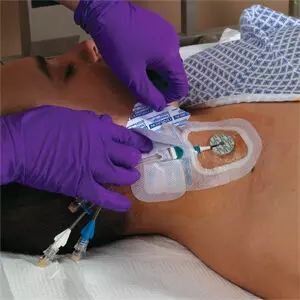Study evaluates Two Techniques Ultrasound- Guided Internal Jugular Vein Cannulation

IJV cannulation is a routine procedure in operating rooms, critical care units, and perioperative settings. Recent research paper compared the success rates of two different ultrasound-guided techniques for internal jugular vein (IJV) cannulation: the “short-axis out-of-plane method with dynamic needle tip positioning (DNTP)” and the “long-axis in-plane (LAIP)” approach.
The study included 100 patients between 18 and 70 years undergoing elective surgery requiring IJV cannulation. Patients were randomly assigned to either the DNTP group (n=50) or the LAIP group (n=50). The primary outcome was the first-pass success rate of IJV cannulation. Secondary outcomes included the number of skin punctures, time to guidewire insertion, total cannulation time, overall success rate within 5 minutes, and any complications like pneumothorax or hematoma.
The results showed that the first-pass success rate was significantly higher in the DNTP group (96%) compared to the LAIP group (76%). The cannulation time was also shorter in the DNTP group (116.98 ± 22.90 seconds) compared to the LAIP group (213.04 ± 52.08 seconds). There were fewer patients requiring more than one skin puncture in the DNTP group compared to the LAIP group. No complications like pneumothorax or hematoma were observed in either group.
The authors concluded that the ultrasound-guided DNTP technique for IJV cannulation, compared to the LAIP technique, can significantly improve the first-pass success rate, reduce the number of attempts, and shorten the cannulation time. This is likely due to the better visualization of the needle tip with the modified short-axis out-of-plane DNTP technique compared to the long-axis in-plane approach. The study suggests that the DNTP technique may be a preferred method for ultrasound-guided IJV cannulation.
Key Points –
The 3 key points of the research paper are:
1. The study compared the success rates of two different ultrasound-guided techniques for internal jugular vein (IJV) cannulation: the “short-axis out-of-plane method with dynamic needle tip positioning (DNTP)” and the “long-axis in-plane (LAIP)” approach.
2. The results showed that the first-pass success rate was significantly higher in the DNTP group (96%) compared to the LAIP group (76%). The cannulation time was also shorter in the DNTP group (116.98 ± 22.90 seconds) compared to the LAIP group (213.04 ± 52.08 seconds). There were fewer patients requiring more than one skin puncture in the DNTP group compared to the LAIP group.
3. The authors concluded that the ultrasound-guided DNTP technique for IJV cannulation, compared to the LAIP technique, can significantly improve the first-pass success rate, reduce the number of attempts, and shorten the cannulation time. This is likely due to the better visualization of the needle tip with the modified short-axis out-of-plane DNTP technique compared to the long-axis in-plane approach.
Reference –
Baidya M, Sinha M, Kumar M, et al. (June 23, 2024) A Randomized Study Comparing Ultrasound-Guided Internal Jugular Vein Cannulation Using Two Techniques: Short-Axis Out-of-Plane With Dynamic Needle Tip Positioning Versus Long-Axis In-Plane. Cureus 16(6): e63004. DOI 10.7759/cureus.63004



